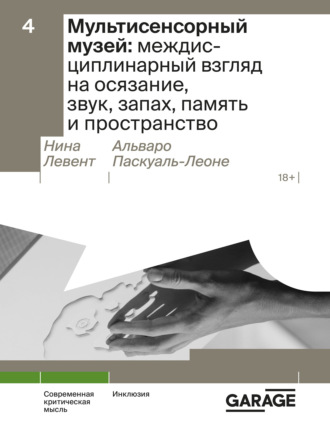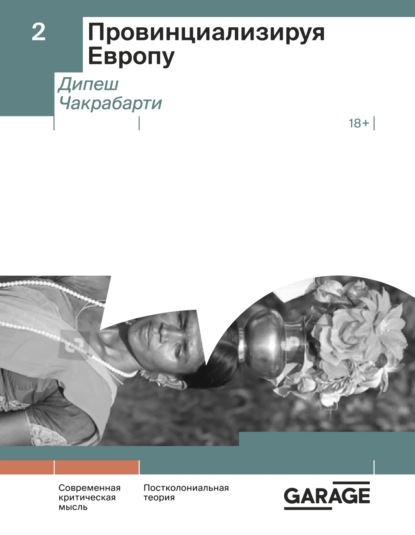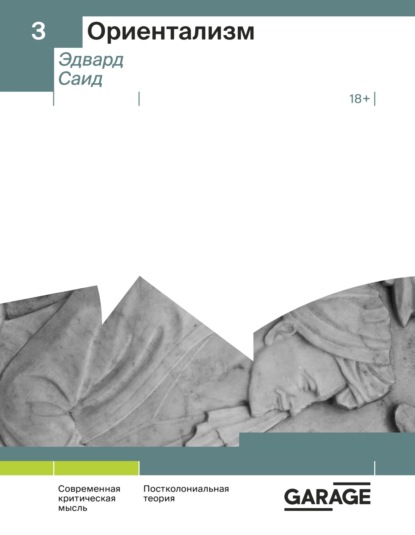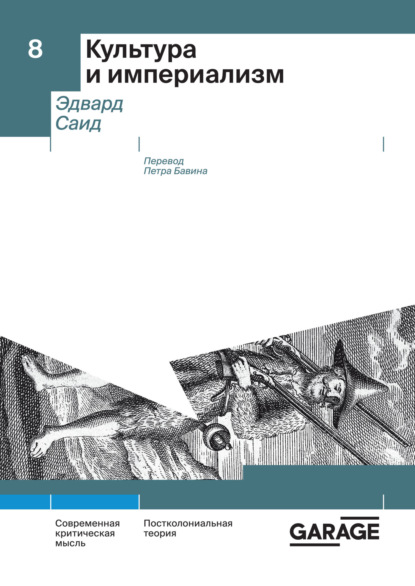
Полная версия
Мультисенсорный музей: междисциплинарный взгляд на осязание, звук, запах, память и пространство
9
Smith B. (1999) The Acoustic World of Early Modern England. Chicago: University of Chicago Press. Medicine and the Five Senses / Bynum W.F., Porter R. (Eds.) (1993) Cambridge: Cambridge University Press. Jütte R. (2005) A History of the Senses. From Antiquity to Cyberspace. Cambridge: Polity Press. Ackerman D. (1991) A Natural History of the Senses. New York: Vintage.
10
The Book of Touch / Classen C. (Ed.).
11
Leahy H.R. (2012) Museum Bodies: The Politics and Practices of Visiting and Viewing. Farnham, Surrey: Ashgate.
12
Candlin F. (2010) Art, Museums and Touch. Manchester: Manchester University Press.
13
The Power of Touch: Handling Objects in Museum and Heritage Context / Pye E. (Ed.) (2008) Walnut Creek: Left Coast Press. Touch in Museums: Policy and Practice in Object Handling / Chatterjee H.J. (Ed.) (2008) Oxford: BERG.
14
Museum Objects: Experiencing the Properties of Things / Dudley S. (Ed.) (2012) London: Routledge. Museum Materialities. Objects, Engagements, Interpretations / Dudley S. (Ed.) (2010) London: Routledge.
15
Birsch J. (2005) Multisensory Teaching of Basic Language Skills. Baltimore: Paul H. Brookes Publishing Co. Campbell M., Shawmla H., Nancy C. (2008) Effects of adding multisensory components to a supplemental reading program on the decoding skills of treatment resisters // Education & Treatment of Children: 267–295. Kerry J., Baker J. (2011) Multisensory information boosts numerical matching abilities in young children // Developmental Science, № 14(2): 205–213. Shams L., Seitz A. (2008) Benefits of multisensory learning // Trends in Cognitive Sciences, № 12(11): 411–417. Scheffel D., Shaw J. and Shaw R. (2008) The efficacy of a supplemental multisensory reading program for first-grade students // Reading Improvement, № 45(3): 139–152.
16
Malatesha J.R., Dahlgren M., Boulware-Gooden R. (2002) Teaching reading in an inner city school through a multisensory teaching approach // Annals of Dyslexia, № 52: 229–242. Axel E., Levent N. (2003) Art Beyond Sight: A Resource on Art, Creativity and Visual Impairment. New York: AFB Press.|Al-Hroub A. (2010) Programming for mathematically gifted children with learning difficulties // Roeper Review, № 32(4): 259–271.
17
Sensorium: Embodied Experience, Technology, and Contemporary Art / Jones C.A. (Ed.) (2006) Cambridge, MA: The MIT Press. Schwartzman M. (2011) See Yourself Sensing. Redefining Human Perception. London: Black Dog Publishing.
18
Aural Cultures / Drobnick J. (Ed.) (2004) Toronto: YYZ Books. The Smell Culture Reader / Drobnick J. (Ed.) (2006) Oxford: Berg.|Voegelin S. (2010) Listening to Noise and Silence: Towards a Philosophy of Sound Art. Continuum. Serres M. (2009) The Five Senses: A Philosophy of Mingled Bodies. London; New York: Bloomsbury Academic Press. Sound. Whitechapel: Documents of Contemporary Art / Kelly C. (Ed.) (2011) MIT Press. Art and the Senses / Bacci F., Melcher D. (Eds.) (2011) Oxford: Oxford University Press.
19
Falk J.H. (2009) Identity and the Museum Visitor Experience. Walnut Creek, CA: Left Coast Press.
20
Mark J. (2007) The Museum Book: A Guide to Strange and Wonderful Collections. Candlewick.
21
Reich C., Lindgren-Streicher A., Beyer M., Levent N., Pursley J., Mesiti L.A. Speaking Out on Art and Museums: Study on the Needs and Preferences of Adults who Are Blind or Have Low Vision. Report. Artbeyondsight.org (https://www.informalscience.org/sites/ default/files/2013-07-03_Speaking_Out_110718.pdf). P. 95.
22
Pallasmaa J. (1996) The Eyes of the Skin. London: Academy Press.
23
Candlin F. Museums, modernity, and the class politics of touching objects // Touch in Museums: Policy and Practice in Object Handling / Chatterjee H.J. (Ed.) (2008) Oxford, UK: Berg: 9–20.
24
Hagen M. C., Franzen O., McGlone F., Essick G., Dancer C., Pardo J. V. (2002) Tactile motion activates the human middle temporal / V5 (MфT/V5) complex // European Journal of Neuroscience, № 16: 957–964. Summers I. R., Francis S. T., Bowtell R. W., McGlone F. P., Clemence M. (2009) A functional magnetic resonance imaging investigation of cortical activation from moving vibrotactile stimuli on the fingertip // Journal of the Acoustical Society of America, № 125: 1033–1039.
25
Stilla R., Sathian K. (2008) Selective visuo-haptic processing of shape and texture // Human Brain Mapping, № 29: 1123–1138; Sathian K., Lacey S., Stilla R., Gibson G. O., Deshpande G., Hu X., Laconte S., Glielmi C. (2011) Dual pathways for haptic and visual perception of spatial and texture information // NeuroImage, № 57: 462–475.
26
Amedi A., Jacobson G., Hendler T., Malach R., Zohary E. (2002) Convergence of visual and tactile shape processing in the human lateral occipital complex // Cerebral Cortex, № 12: 1202–1212; Amedi A., Malach R., Hendler T., Peled S., Zohary E. (2001) Visuo-haptic object-related activation in the ventral visual pathway // Nature Neuroscience, № 4: 324–330; Zhang M., Weisser V. D., Stilla R., Prather S. C., Sathian K. (2004) Multisensory cortical processing of object shape and its relation to mental imagery // Cognitive, Affective, & Behavioral Neuroscience, № 4: 251–259; Stilla R., Sathian K. (2008).
27
Pascual-Leone A., Hamilton R. H. (2001) The metamodal organization of the brain // Progress in Brain Research, № 134: 427–445. Lacey S., Tal N., Amedi A., Sathian K. (2009а) A putative model of multisensory object representation // Brain Topography, № 21: 269–274. James T. W., VanDerKlok R. M., Stevenson R. A., James K.H. (2011) Multisensory perception of action in posterior temporal and parietal cortices // Neuropsychologia, № 49: 108–114.
28
Sathian K., Zangaladze A., Hoffman J. M., Grafton S.T. (1997) Feeling with the mind’s eye // NeuroReport, № 8: 3877–3881.
29
Подробнее см.: Peissig J.J., Tarr M.J. (2007) Visual object recognition: Do we know more now than we did 20 years ago? // Annual Review of Psychology, № 58: 75–96; Lacey S., Sathian K. (2011) Multisensory object representation: insights from studies of vision and touch // Progress in Brain Research, № 191: 165–176.
30
Peissig J.J., Tarr M.J. 2007. Lawson R. (2009) A comparison of the effects of depth rotation on visual and haptic three-dimensional object recognition // Journal of Experimental Psychology: Human Perception and Performance, № 35: 911–930.
31
Использующего информацию в рамках одной сенсорной системы (прим. науч. ред.).
32
В которое вовлечены разные органы чувств (прим. науч. ред.).
33
Lacey S., Peters A., Sathian K. (2007а) Cross-modal object representation is viewpoint-independent // PLoS ONE, № 2: 890.
34
Lawson R., 2009.
35
Прим. науч. ред.: Обучение перцептивным способностям (способностям восприятия), которое позволяет приобрести изменения реакций на сенсорные стимулы в ходе повторных воздействий этих стимулов. По сути, речь идет о развитии навыков восприятия (осязание, обоняние и т. д.) См. про исследование: Lacey S., Campbell C. and Sathian K. (2007b). Vision and touch: Multiple or multisensory representations of objects? Perception, 36, 1513–21.
36
Kosslyn S.M. (1980) Image and Mind. Cambridge: Harvard University Press; Kosslyn S.M. (1994) Image and Brain: The Resolution of the Imagery Debate. Cambridge: MIT Press.
37
Röder B., Rösler F. (1998) Visual input does not facilitate the scanning of spatial images // Journal of Mental Imagery, № 22: 165–181.
38
Shepard R.N., Metzler J. (1971) Mental rotation of three-dimensional objects // Science, № 171: 701–703; Kosslyn S.M. (1980); Kosslyn S.M. (1994).
39
Marmor G.S., Zaback L.A. (1976) Mental rotation by the blind: does mental rotation depend on visual imagery? // Journal of Experimental Psychology: Human Perception & Performance, № 2: 515–521; Carpenter P.A., Eisenberg P. (1978) Mental rotation and the frame of reference in blind and sighted individuals // Perception & Psychophysics, № 23: 117–124; Dellantonio A., Spagnolo F. (1990) Mental rotation of tactual stimuli // Acta Psychologica, № 73: 245–257.
40
Prather S.C., Votaw J.R., Sathian K. (2004) Task-specific recruitment of dorsal and ventral visual areas during tactile perception // Neuropsychologia, № 42: 1079–1087.
41
Alivisatos B., Petrides M. (1997) Functional activation of the human brain during mental rotation // Neuropsychologia, № 35: 111–118.
42
Carpenter P.A. Eisenberg P. (1978); Röder B., Rösler F. (1998).
43
Röder B., Rösler F. (1998).
44
Kozhevnikov M., Hegarty M., Mayer R.E. (2002) Revising the visualiserverbaliser dimension: evidence for two types of visualisers // Cognition & Instruction, № 20: 47–77; Kozhevnikov M., Kosslyn S.M., Shephard J. (2005) Spatial versus object visualisers: A new characterisation of cognitive style // Memory & Cognition, № 33: 710–726; Blajenkova O., Kozhevnikov M., Motes M.A. (2006) Object-spatial imagery: a new self-report imagery questionnaire // Applied Cognitive Psychology, № 20: 239–263.
45
Lacey S., Lin J.B., Sathian K (2011) Object and spatial imagery dimensions in visuo-haptic representations // Experimental Brain Research, № 213: 267–273.
46
В задании использовались деревянные блоки, имевшие разные текстуру за счет покрытия наждачной бумагой, бумагой с текстом, набранным шрифтом Брайля, бархатной тканью. Еще один блок оставался гладким (прим. науч. ред.).
47
Cм. Lacey S. et al. (2009b).
48
Lacey S. et al. (2011).
49
Lacey S., Campbell C. (2006) Mental representation in visual / haptic crossmodal memory: Evidence from interference effects // Quarterly Journal of Experimental Psychology, № 59: 361–376.
50
Lacey S. et al. (2007a).
51
Malach R., Reppas J.B., Benson R.R., Kwong K.K., Jiang H., Kennedy W.A., Ledden P.J., Brady T.J., Rosen B.R., Tootell R.B. (1995) Object-related activity revealed by functional magnetic resonance imaging in human occipital cortex // Proceedings of the National Academy of Sciences USA, № 92: 8135–8139.
52
Amedi A., Malach R., Hendler T., Peled S., Zohary E. (2001) Visuohaptic object-related activation in the ventral visual pathway // Nature Neuroscience, № 4: 324–330; Amedi A. et al. (2002).
53
Amedi A. et al. (2001); Zhang M. et al. (2004); Stilla R., Sathian K. (2008).
54
Stoesz M., Zhang M., Weisser V.D., Prather S.C., Mao H., Sathian K. (2003) Neural networks active during tactile form perception: Common and differential activity during macrospatial and microspatial tasks // International Journal of Psychophysiology, № 50: 41–49; Prather S.C. et al. (2004).
55
Amedi A. et al. (2002).
56
Amedi A., Stern W.M., Camprodon J.A., Bermpohl F., Merabet L., Rotman S., Hemond C., Meijer P., Pascual-Leone A. (2007) Shape conveyed by visual-to-auditory sensory substitution activates
57
Amedi A. et al. (2007).
58
Stilla R., Sathian K. (2008).
59
Zhou Y.-D., Fuster J.M. (1997) Neuronal activity of somatosensory cortex in a cross-modal (visuo-haptic) memory task // Experimental Brain Research, № 116: 551–555; Iwamura Y. (1998) Hierarchical somatosensory processing // Current Opinion in Neurobiology, № 8: 522–528.
60
Grefkes C., Weiss P.H., Zilles K., Fink G.R. (2002) Crossmodal processing of object features in human anterior intraparietal cortex: An fMRI study implies equivalencies between humans and monkeys // Neuron, № 35: 173–184; Saito D.N., Okada T., Morita Y., Yonekura Y., Sadato N. (2003) Tactile-visual cross-modal shape matching: A functional MRI study // Cognitive Brain Research, № 17: 14–25; Stilla R., Sathian K. (2008).
61
Feinberg T.E., Rothi L.J., Heilman K.M. (1986) Multimodal agnosia after unilateral left hemisphere lesion // Neurology, № 36: 864–867.
62
James T.W., James K.H., Humphrey G.K., Goodale M.A. (2006) Do visual and tactile object representations share the same neural substrate? // Touch and Blindness: Psychology and Neuroscience / Heller M.A., Ballesteros S. (Eds.) Mahwah: Lawrence Erlbaum Associates: 139–155.
63
Sathian K. et al. (1997).
64
Zangaladze A., Epstein C.M., Grafton S.T., Sathian K. (1999) Involvement of visual cortex in tactile discrimination of orientation // Nature, № 401: 587–590.
65
Mullin C.R., Steeves J.K.E. (2011) TMS to the lateral occipital cortex disrupts object processing but facilitates scene processing // Journal of Cognitive Neuroscience, № 23: 4174–4184.
66
Buelte D., Meister I.G., Staedtgen M., Dambeck N., Sparing R., Grefkes C., Boroojerdi B. (2008) The role of the anterior intraparietal sulcus in crossmodal processing of object features in humans: An rTMS study // Brain Research., № 1217: 110–118.
67
Sathian K. et al. (1997).
68
De Volder A.G., Toyama H., Kimura Y., Kiyosawa M., Nakano H., Vanlierde A., Wanet-Defalque M.C., Mishina M., Oda K., Ishiwata K., Senda M. (2001) Auditory triggered mental imagery of shape involves visual association areas in early blind humans // NeuroImage, № 14: 129–139.
69
Newman S.D., Klatzky R.L., Lederman S.J., Just M.A. (2005) Imagining material versus geometric properties of objects: An fMRI study // Cognitive Brain Research, № 23: 235–246.
70
Zhang M. et al. (2004).
71
Pietrini P., Furey M.L., Ricciardi E., Gobbini M.I., WuW.-H.C., Cohen L., Guazzelli M., Haxby J.V. (2004) Beyond sensory images: Object-based representation in the human ventral pathway // Proceedings of the National Academy of Sciences USA, № 101; 5658–5663.
72
Sathian K. (2005) Visual cortical activity during tactile perception in the sighted and the visually deprived // Developmental Psychobiology, № 46: 279–286; Sathian K., Stilla R. (2010) Cross-modal plasticity of tactile perception in blindness // Restorative Neurology and Neuroscience, № 28: 271–281.
73
Amedi A. et al. (2001). Reed C.L., Shoham S., Halgren E. (2004) Neural substrates of tactile object recognition: An fMRI study // Human Brain Mapping, № 21: 236–246.
74
Sathian K. (2004) Modality, quo vadis?: Comment // Behavioral & Brain Sciences, № 27: 413–414.
75
В исследованиях с применением фМРТ можно обнаружить большое количество статистически значимых связей активности одного отдела мозга с другим, но на основании наличия корреляции невозможно установить причину этой связи. Особую ценность представляют поиски эффективных связей, которые отражают взаимное влияние отделов мозга друг на друга, и стоящие за ними нейрональные связи. Такие исследования требуют специального дизайна. О некоторых из них авторы статьи рассказывают дальше (прим. науч. ред.).
76
Peltier S., Stilla R., Mariola E., LaConte S., Hu X., Sathian K. (2007) Activity and effective connectivity of parietal and occipital cortical regions during haptic shape perception // Neuropsychologia, № 45: 476–483; Deshpande G., Hu X., Stilla R., Sathian K. (2008) Effective connectivity during haptic perception: A study using Granger causality analysis of functional magnetic resonance imaging data // NeuroImage, № 40: 1807–1814.
77
Lucan J.N., Foxe J.J., Gomez-Ramirez M., Sathian K., Molholm S. (2010) Tactile shape discrimination recruits human lateral occipital complex during early perceptual processing // Human Brain Mapping, № 31: 1813–1821.
78
Peltier S. et al. (2007); Deshpande G. et al. (2008).
79
Deshpande G., Hu X., Lacey S., Stilla R., Sathian K. (2010) Object familiarity modulates effective connectivity during haptic shape perception // NeuroImage, № 49: 1991–2000; Lacey S., Flueckiger P., Stilla R., Lava M., Sathian K. (2010) Object familiarity modulates the relationship between visual object imagery and haptic shape perception // NeuroImage, № 49: 1977–1990.
80
Lacey S. et al. (2010).
81
См. подробнее: Lacey S. et al. (2010).
82
Deshpande G. et al. (2008).
83
Lacey S., Campbell C., Sathian K. (2007b) Vision and touch: Multiple or multisensory representations of objects? // Perception, № 36: 1513–1521.
84
Mechelli A., Price C.J., Friston K.J., Ishai A. (2004) Where bottom-up meets top-down: neuronal interactions during perception and imagery // Cerebral Cortex, № 14: 1256–1265.
85
Peltier S. et al. (2007); Deshpande G. et al. (2008).
86
Lacey S. et al. (2009a).
87
Stilla R. Sathian K. (2008); Sathian K. et al. (1997).
88
Lacey S., Stilla R., Porath M., Tipler C., Sathian K. (2012). Spatial imagery in haptic shape perception // Abstract, Society for Neuroscience, New Orleans, October 13–17.
89
Lacey S. et al. (2012).
90
Heller M.A. (2006) Picture perception and spatial cognition in visually impaired people // Touch and Blindness: Psychology and Neuroscience / Heller M.А., Ballesteros S. (Eds.) Mahwah: Lawrence Erlbaum Associates.
91
University of Leicester announces discovery of King Richard III (https://www2.le.ac.uk/offices/press/press-releases/2013/february/ university-of-leicester-announces-discovery-of-king-richard-iii).
92
The Book of Touch / Classen С. (Ed.) (2005) Oxford and New York: Berg: 274.
93
The Book of Touch / Classen С. (Ed.)
94
Longo M.R., Kammers M.P.M., Gomi H., Tsakiris M., Haggard P. (2009) Contraction of body representation induced by proprioceptive conflict // Current Biology, № 19: R727–R728.
95
Craig A.D. (2002) How do you feel? Interoception: The sense of the physiological condition of the body // Nat. Rev. Neuroscience, № 3(8): 655–666.
96
Ernst M.O., Banks M.S. (2002) Humans integrate visual and haptic information in a statistically optimal fashion // Nature, № 415: 429–433. Alais D., Burr D. (2004) The ventriloquist effect results from near-optimal bimodal integration // Curr. Biol, № 14: 257–262.
97
Montgomery S.M. Emergence (http://produceconsumerobot.com/emergence/).
98
Seth A.K., Suzuki K., Critchley H.D. (2011) An interoceptive predictive coding model of conscious presence // Front Psychol, № 2: 395.
99
Боди-арт включает в себя шрамирование, пирсинг и другие виды телесных изменений (прим. науч. ред.).
100
Avenanti A., Bueti D., Galati G., Aglioti S.M. (2005) Transcranial magnetic stimulation highlights the sensorimotor side of empathy for pain // Nature Neuroscience, № 8: 955–960.
101
Urban P.P., Solinski M., Best C., Rolke R., Hopf H.C., Dieterich M. (2004) Different short-term modulation of cortical motor output to distal and proximal upper-limb muscles during painful sensory nerve stimulation // Muscle Nerve, № 29: 663–669.
102
Singer T., Seymour B., O’Doherty J., Kaube H., Dolan R.J., Frith C.D. (2004) Empathy for pain involves the affective but not sensory components of pain // Science, № 303: 1157–1162.
103
Singer T., Lamm C. (2009) The social neuroscience of empathy // Annals of the New York Academy of Science, № 1156: 81–96.
104
Lang S., Yu T., Markl A., Müller F., Kotchoubey B. (2011) Hearing others’ pain: Neural activity related to empathy // Cognitive Affective Behavioral Neuroscience, № 11: 386–395.
105
Hyvärinen J., Poranen A. (1974) Function of the parietal associative area 7 as revealed from cellular discharges in alert monkeys // Brain, № 97: 673–692.
106
Graziano M.S., Yap G.S., Gross C.G. (1994) Coding of visual space by premotor neurons // Science, № 266: 1054–1057. Rizzolatti G., Scandolara C., Matelli M., Gentilucci M. (1981) Afferent properties of periarcuate neurons in macaque monkeys. II. Visual responses // Behavioral Brain Research, № 2: 147–163.
107
Makin T.R., Holmes N.P., Zohary E. (2007) Is that near my hand? Multisensory representation of peripersonal space in human intraparietal sulcus // Journal of Neuroscience, № 27: 731–740.
108
Graziano M.S., Reiss L.A., Gross C.G. (1999) A neuronal representation of the location of nearby sounds // Nature, № 397: 428–430.
109
Làdavas E., Pavani F., Farné A. (2001) Auditory peripersonal space in humans: A case of auditory-tactile extinction // Neurocase, № 7: 97–103.
110
Rizzolatti G. et al. 1981.
111
Lourenco S.F., Longo M.R., Pathman T. (2011) Near space and its relation to claustrophobic fear // Cognition, № 119: 448–453.
112
FMGB Guggenheim Bilbao Museoa (https://www.guggenheim-bilbao.eus/exposiciones/ richard-serra).
113
Rizzolatti G., Craighero L. (2004) The mirror-neuron system // Annual Review of Neuroscience, № 27: 169–192.
114
Gibson J.J. (1966) The Senses Considered as Perceptual Systems. Boston, MA: Houghton Mifflin.
115
Piéron H. (1953) La Sensation. Paris: Presses Universitaries de France.






